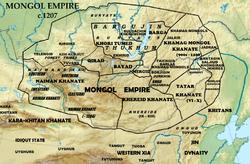Tatar confederation: Difference between revisions
No edit summary |
put an refereence on origin |
||
| Line 77: | Line 77: | ||
|footnotes = |
|footnotes = |
||
}} |
}} |
||
'''Tatar''' ({{lang-mn|Татар}}) was one of the five major [[Mongols|Mongol |
'''Tatar''' ({{lang-mn|Татар}}) was one of the five major [[Mongols|Mongol]],[[Turkic peoples|Turkic]],[[Tungusic people|Tungusic]]<ref name="https://books.google.se/books?id=ZJguDwAAQBAJ&pg=PT360&dq=tatar+tribal+confederation&hl=sv&sa=X&ved=0ahUKEwijporIudzXAhXkQpoKHbKkAoAQ6AEIJjAA#v=onepage&q=tatar%20tribal%20confederation&f=false">{{cite book|last1=Evgeny Khvalkov|title=The Colonies of Genoa in the Black Sea Region: Evolution and Transformation|date=2017|publisher=Routledge.|page=https://books.google.se/books?id=ZJguDwAAQBAJ&pg=PT360&dq=tatar+tribal+confederation&hl=sv&sa=X&ved=0ahUKEwijporIudzXAhXkQpoKHbKkAoAQ6AEIJjAA#v=onepage&q=tatar%20tribal%20confederation&f=false}}</ref> tribal confederations (khanlig) in the [[Mongolian Plateau]] in the 12th century. The name "[[Tatar]]" was first recorded on the [[Kul Tigin]] monument as [[File:Old Turkic letter N1.svg|10px]][[File:Old Turkic letter D1.svg|10px]][[File:Old Turkic letter O.svg|10px]][[File:Old Turkic letter B1.svg|10px]][[File:Old Turkic letter R1.svg|10px]][[File:Old Turkic letter T1.svg|10px]][[File:Old Turkic letter T1.svg|10px]][[File:Old Turkic letter Z.svg|10px]][[File:Old Turkic letter T1.svg|10px]][[File:Old Turkic letter O.svg|10px]] Otuz Tatar Bodun ('Thirty Tatar' tribe), 732. Subsequently the wider region was referred to by Europeans as "[[Tartary]]" or "[[Tartaria]]". |
||
The Tatars inhabited the north-eastern [[Gobi]] in the 5th century and the Tatars became subjects of the [[Khitan people|Khitan]] [[Liao dynasty]] in the 10th century. After the fall of the Liao, the Tatars experienced pressure from the [[Jin dynasty (1115–1234)|Jurchen Jin dynasty]] and were urged to fight against the other Mongol tribes. The Tatars lived on the fertile pastures around [[Hulun Nuur]] and [[Buir Nuur]] and occupied a trade route to [[China]] in the 12th century. |
The Tatars inhabited the north-eastern [[Gobi]] in the 5th century and the Tatars became subjects of the [[Khitan people|Khitan]] [[Liao dynasty]] in the 10th century. After the fall of the Liao, the Tatars experienced pressure from the [[Jin dynasty (1115–1234)|Jurchen Jin dynasty]] and were urged to fight against the other Mongol tribes. The Tatars lived on the fertile pastures around [[Hulun Nuur]] and [[Buir Nuur]] and occupied a trade route to [[China]] in the 12th century. |
||
Revision as of 15:22, 26 November 2017
Tatar Nine Tatars Татарын ханлиг | |
|---|---|
| 8th century–1202 | |
 Tatar and their neighbours in the 13th century. | |
| Status | nomadic confederation |
| Common languages | Middle Mongolian |
| Religion | Shamanism |
| Government | Elective monarchy |
| chief | |
| Legislature | Kurultai |
| Historical era | High Middle Ages |
• Established | 8th century |
• Disestablished | 1202 |
| Today part of | |
Tatar (Mongolian: Татар) was one of the five major Mongol,Turkic,Tungusic[1] tribal confederations (khanlig) in the Mongolian Plateau in the 12th century. The name "Tatar" was first recorded on the Kul Tigin monument as ![]()
![]()
![]()
![]()
![]()
![]()
![]()
![]()
![]()
![]() Otuz Tatar Bodun ('Thirty Tatar' tribe), 732. Subsequently the wider region was referred to by Europeans as "Tartary" or "Tartaria".
Otuz Tatar Bodun ('Thirty Tatar' tribe), 732. Subsequently the wider region was referred to by Europeans as "Tartary" or "Tartaria".
The Tatars inhabited the north-eastern Gobi in the 5th century and the Tatars became subjects of the Khitan Liao dynasty in the 10th century. After the fall of the Liao, the Tatars experienced pressure from the Jurchen Jin dynasty and were urged to fight against the other Mongol tribes. The Tatars lived on the fertile pastures around Hulun Nuur and Buir Nuur and occupied a trade route to China in the 12th century.
After the establishment of the Mongol Empire, the Tatars were subjugated by the Mongol Empire under Genghis Khan. Under the leadership of his grandson Batu Khan, they moved westwards, driving with them many of the Turkic peoples toward the plains of Russia in the Turkic migrations.
Their name was used by Russians and Europeans to denote Mongols as well as Turkic peoples under Mongol rule, especially in the Golden Horde. Later, it was used for any Turkic or even Mongolic-speaking people encountered by Russians. Eventually however, the name stuck onto the Turkic Muslims of Ukraine and Russia, namely, the descendants of Muslim Volga Bulgars, Kipchaks, and Cumans, and Turkicized Mongols or Turco-Mongols (Nogais), as well as other Turkic speaking peoples (Siberian Tatars, Qasim Tatars, Mishar Tatars).
- ^ Evgeny Khvalkov (2017). The Colonies of Genoa in the Black Sea Region: Evolution and Transformation. Routledge. p. https://books.google.se/books?id=ZJguDwAAQBAJ&pg=PT360&dq=tatar+tribal+confederation&hl=sv&sa=X&ved=0ahUKEwijporIudzXAhXkQpoKHbKkAoAQ6AEIJjAA#v=onepage&q=tatar%20tribal%20confederation&f=false.
